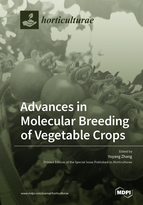Advances in Molecular Breeding of Vegetable Crops
A special issue of Horticulturae (ISSN 2311-7524). This special issue belongs to the section "Genetics, Genomics, Breeding, and Biotechnology (G2B2)".
Deadline for manuscript submissions: closed (31 October 2021) | Viewed by 62137
Special Issue Editor
Interests: the vegetable quality (nutrition, flavor) formation and its regulation; molecular biology and biotechnology applied in vegetable crops; vegetable germplasm enhancement and molecular breeding
Special Issues, Collections and Topics in MDPI journals
Special Issue Information
Dear Colleagues,
Vegetable crops provide the vast majority of vitamins, minerals, antioxidants and bioactivity substances that are necessary for humans—they are insufficient in grains or meat. With the demands for better and healthier diets, consumers require more vegetables and fruits. The increasing genome data and breeding technology facilitate the genetic improvement of vegetables on yield and tolerance to disease and abiotic stress. Nowadays, consumers demand more nutrition and taste from vegetables. Genes and genomes underlying the important horticultural traits—e.g., yield, quality, disease resistance, and stress tolerance—have been extensively investigated, which paves the way for the molecular breeding of vegetable crops.
Therefore, in this Special Issue of “Molecular Breeding of Vegetable Crops”, we aim to provide an updated review of recent advances in genes and genetics, and the molecular breeding of vegetables. Indeed, molecular breeding technology has been widely applied in vegetable improvement. We look forward to receiving your manuscripts (reviews and research articles) and are eager to share your knowledge within the research and industry communities.
Prof. Dr. Yuyang Zhang
Guest Editor
Manuscript Submission Information
Manuscripts should be submitted online at www.mdpi.com by registering and logging in to this website. Once you are registered, click here to go to the submission form. Manuscripts can be submitted until the deadline. All submissions that pass pre-check are peer-reviewed. Accepted papers will be published continuously in the journal (as soon as accepted) and will be listed together on the special issue website. Research articles, review articles as well as short communications are invited. For planned papers, a title and short abstract (about 100 words) can be sent to the Editorial Office for announcement on this website.
Submitted manuscripts should not have been published previously, nor be under consideration for publication elsewhere (except conference proceedings papers). All manuscripts are thoroughly refereed through a single-blind peer-review process. A guide for authors and other relevant information for submission of manuscripts is available on the Instructions for Authors page. Horticulturae is an international peer-reviewed open access monthly journal published by MDPI.
Please visit the Instructions for Authors page before submitting a manuscript. The Article Processing Charge (APC) for publication in this open access journal is 2200 CHF (Swiss Francs). Submitted papers should be well formatted and use good English. Authors may use MDPI's English editing service prior to publication or during author revisions.
Keywords
- genes
- genetics
- breeding
- vegetable crop
- improvement
- yield
- quality
- disease resistance
- stress tolerance






